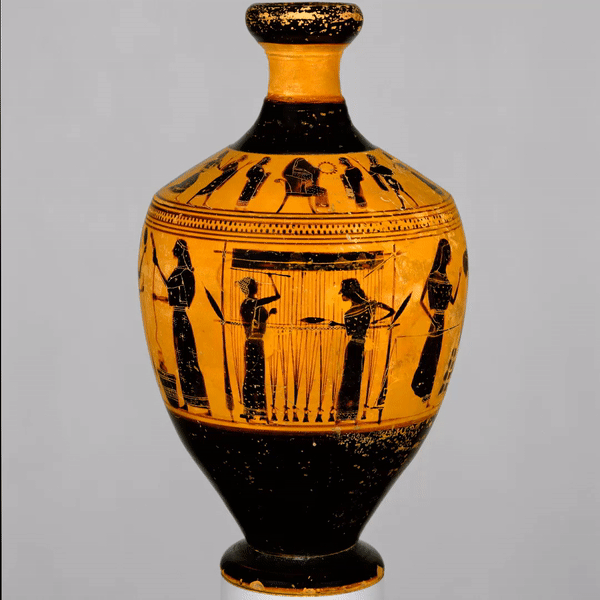For this week’s #FolkloreThursday theme (the folklore of of Art, Colours and Creativity) and following a big update of our website, including our new Animations page, we realised this was the perfect time to do a bit of a deep dive into Ancient Greek vases. And yes, while that does make us Classics nerds of the highest order, these dusty old pots can tell you a lot about the Ancient World!
Art
Before we can talk about Ancient Greek vases, we’ve got to talk about Ancient Greek pots. Cause there are lots. Different styles, different periods, famous painters, famous workshops and of course, a whole range of conditions in which they’ve survived from the perfectly preserved to the completely crumbly. But for the sake of this blog’s brevity, we’re going to stick to perhaps the most well-known and iconic of Ancient Greek pots – the pot de résistance if you will – red-figure and black-figure vases, mostly made in Athens around the 5th Century BC. Athens was at this time the dominant producer of decorated pots, exporting them all around the Mediterranean.
Black-figure vases showing scenes from the life of Heracles. From L to R: Water Jar Attributed to the Eagle Painter, about 525 BC, showing Heracles and the Hydra; Attic black figure amphora, c. 560-530 BC, Heracles and the Stymphalian Birds (Photograph courtesy of the Trustees of the British Museum, London); Attic black figure amphora, c. 530-520 BC, Hercules raises his club to hit a centaur.
Black-figure vases are the earlier type and, much as the name suggests, shows black figures on a light inset background panel, with the surrounding vase in black. This distinctive look was achieved by a very complicated three-stage firing process (with many things that could go wrong). We know this because it has been analysed and successfully reproduced in the modern day – how’s that for creativity! Any detail for the figures was then etched into the fired pot, and limited amounts of white paint used (usually to indicate a female figure, or add tiny detail).
Red-figure was invented by the Athenians slightly later (c. 530BC) and is simply the inverse of the above, with the negative of the image filled with black, and revealing the scene in the red clay figures. As the figures were lighter, black paint could be used to give much more detail (as a tiny paintbrush could be used much more dextrously than an incising tool). Further appeal came from the more realistic human skin tones that could be achieved, as well as the sheer drama created by a dark backdrop (and we all know the Greeks were there for the drama). Red-figure coincided with plenty of other artistic developments too – figures ceased to be only in profile, instead appearing in jaunty 3/4 poses, while overlapping figures and foreshortening added yet more drama and movement.
Red-figure vases showing (yet more) scenes from the life of Heracles. From L to R: Attic red-figure stamnos, c. 490 BC, Heracles wrestles the Nemean Lion; Apulian red-figure calyx krater, c. 430-420 BC, a centaur about to attack Heracles; Attic red-figure hydria, ca. 410-400 BC, showing Heracles in the garden of the Hesperides.
Art feat. Myth
So what does any of this have to do with folklore? Well, Greek pots decorated with scenes we can positively identify as being from mythology appear as early as the 8th Century BC, at the end of the Geometric period (human and animal figures appear well before this, but it is impossible to say if they are scenes from myth/legend or simply daily life). By the time we reach our Athenian 5th Century BC potters, scenes from stories, myths and folklore are an overwhelmingly common choice (along with scenes from daily life). Through this, pottery has preserved some of the earliest records of Greek storytelling. The frequency of certain characters tells us a lot about how well known a particular story is too (as well as presumably about how exciting a scene it is to decorate!). Take Hercules (or Heracles as he was in Greece) for example; scenes from his legends first appear in the first myth-decorated pots in the late Geometric period (8th Century BC) and his popularity never wanes, as all the examples above show. If you’re new to this Greek pottery game, he’s your easiest spot; he’s rarely ever without his lion skin and large club, like in this Caeretan hydria (c. 530 BC) from Caere, that we animated for #NationalPetDay. You can find out more about it on our Animations page!

Art feat. Myth about Art
Having never seen a rabbit hole that we couldn’t get lost in, we wanted to move past mere art featuring mythology and onto art featuring mythology in which people are doing art! And in that theme (and with such a torturous sentence to unravel), there’s really one person who can help us: wise Penelope of Ithaca.
She has waited for twenty years. Twenty long years since her husband, that man of many twists and turns, Odysseus, set sail to fight before the gates of Troy. The last decade has seen other kings return from that war – Agamemnon, Diomedes, Menelaus – and so she waits in hope that one day the waves crashing over rocky Ithaca will see fit to return her king. But she does not wait empty-handed. For the men of the island, her suitors, have grown impatient. They besiege her, they bother and they badger, growing fat on the hospitality of the royal house – the wealth and birth-right of her son Telemachus. And so wise Penelope has devised a trick. She promises to marry one of them – they cheered and leered – but not until she has completed a funeral shroud for Odysseus’s elderly father. And so, each day, in the courtyard for all to see, she hurries her shuttle across the loom, all skill and show and craft. But come each night, she steals to her loom and gazes out across the wine dark sea while her fingers go about unravelling the day’s work.
She has kept her suitors at bay now for three years with this trick, this perpetual shroud. Three long years of weaving, unravelling and waiting. How many more?
Art of Art feat. Myth about Art

We heard you like art…
And so, with the art of wise Penelope in mind, we’ve made some art of our own – animating this Terracotta lekythos (an oil flask) and the two weaving women it depicts (more scenes of wool-working and cloth-making can be seen on the rest of the pot too). Dated back to c. 550–530 BC and attributed to the Amasis Painter, it’s on display over at the Metropolitan Museum of Art (which also has lots more fantastic images and information about this particular piece so do check it out!).

As a final titbit, and because we learnt a lot whilst making this animation, here’s how weaving at the kind of upright loom depicted would actually have worked. The shuttle (the narrow seed shaped object which would have had yarn wrapped around it) is moved between every other vertical thread. The lady on the left in our pot then pushes the thread up to join the rest. This video shows it much more clearly: fair warning it’s in Greek, and the music is a lot!
And so with that, we’re going to bring this blog post on the smashing (eyyyy) subject of Ancient Greek pots to a close. But never fear, we’ll be back with more posts soon!





